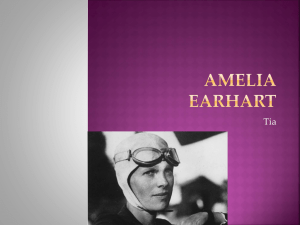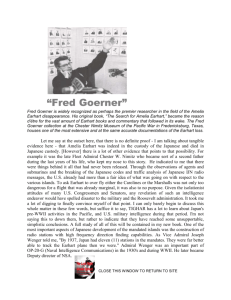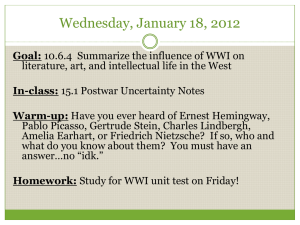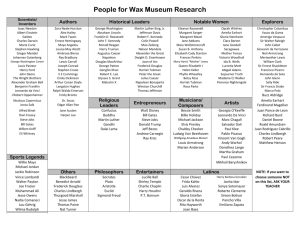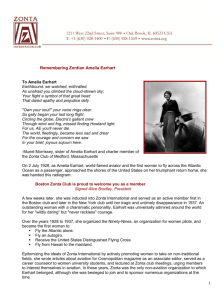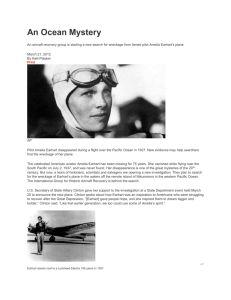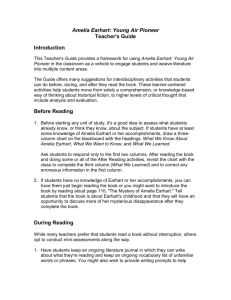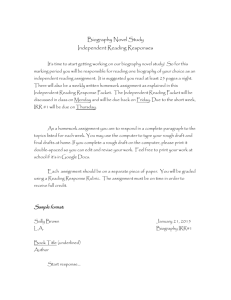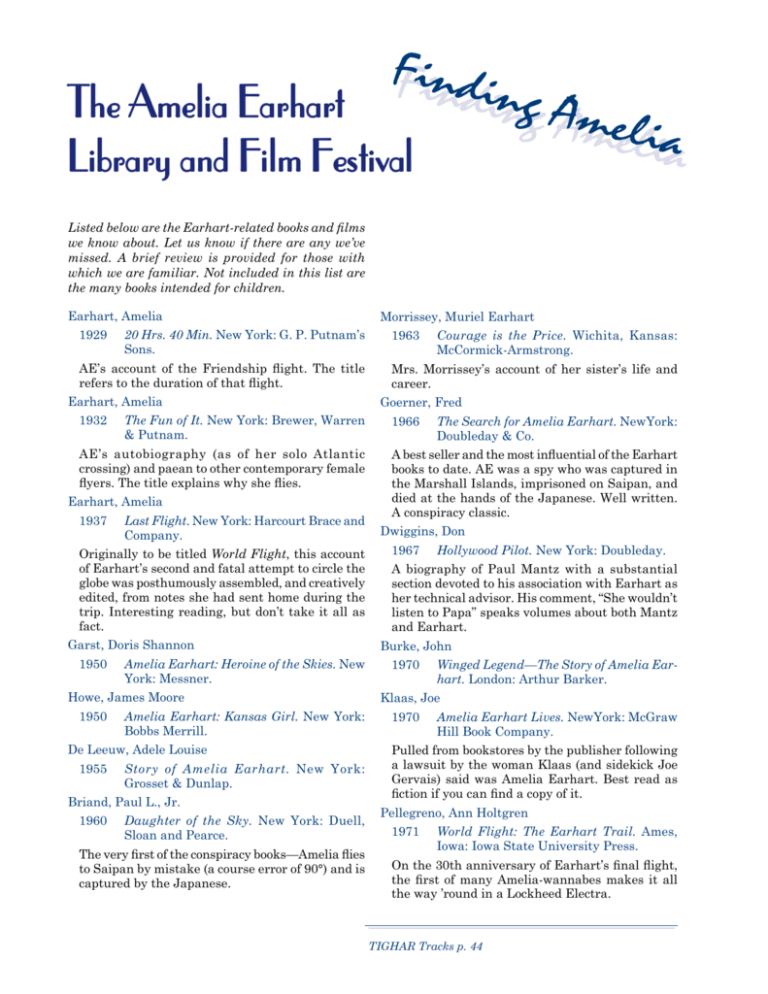
FFiind
ndiinng A
The Amelia Earhart
g Am
meelliiaa
Library and Film Festival
Listed below are the Earhart‑related books and films
we know about. Let us know if there are any we’ve
missed. A brief review is provided for those with
which we are familiar. Not included in this list are
the many books intended for children.
Earhart, Amelia
1929
20 Hrs. 40 Min. New York: G. P. Putnam’s
Sons.
AE’s account of the Friendship flight. The title
refers to the duration of that flight.
Earhart, Amelia
1932
The Fun of It. New York: Brewer, Warren
& Putnam.
AE’s autobiography (as of her solo Atlantic
crossing) and paean to other contemporary female
flyers. The title explains why she flies.
Earhart, Amelia
1937
Last Flight. New York: Harcourt Brace and
Company.
Originally to be titled World Flight, this account
of Earhart’s second and fatal attempt to circle the
globe was posthumously assembled, and creatively
edited, from notes she had sent home during the
trip. Interesting reading, but don’t take it all as
fact.
Garst, Doris Shannon
1950
Amelia Earhart: Heroine of the Skies. New
York: Messner.
Howe, James Moore
1950
Amelia Earhart: Kansas Girl. New York:
Bobbs Merrill.
De Leeuw, Adele Louise
1955
Story of Amelia Earhart. New York:
Grosset & Dunlap.
Briand, Paul L., Jr.
1960
Daughter of the Sky. New York: Duell,
Sloan and Pearce.
The very first of the conspiracy books—Amelia flies
to Saipan by mistake (a course error of 90°) and is
captured by the Japanese.
Morrissey, Muriel Earhart
1963
Courage is the Price. Wichita, Kansas:
McCormick‑Armstrong.
Mrs. Morrissey’s account of her sister’s life and
career.
Goerner, Fred
1966
The Search for Amelia Earhart. NewYork:
Doubleday & Co.
A best seller and the most influential of the Earhart
books to date. AE was a spy who was captured in
the Marshall Islands, imprisoned on Saipan, and
died at the hands of the Japanese. Well written.
A conspiracy classic.
Dwiggins, Don
1967
Hollywood Pilot. New York: Doubleday.
A biography of Paul Mantz with a substantial
section devoted to his association with Earhart as
her technical advisor. His comment, “She wouldn’t
listen to Papa” speaks volumes about both Mantz
and Earhart.
Burke, John
1970
Winged Legend—The Story of Amelia Ear­
hart. London: Arthur Barker.
Klaas, Joe
1970
Amelia Earhart Lives. NewYork: McGraw­
Hill Book Company.
Pulled from bookstores by the publisher following
a lawsuit by the woman Klaas (and sidekick Joe
Gervais) said was Amelia Earhart. Best read as
fiction if you can find a copy of it.
Pellegreno, Ann Holtgren
1971
World Flight: The Earhart Trail. Ames,
Iowa: Iowa State University Press.
On the 30th anniversary of Earhart’s final flight,
the first of many Amelia‑wannabes makes it all
the way ’round in a Lockheed Electra.
TIGHAR Tracks p. 44
Devine, Thomas E., with Richard M. Daley
Davidson, Joe
1972
Amelia Earhart Returns from Saipan.
Canton, Ohio: Davidson Publishing
Company.
When the name of the author and the publisher
match—it’s a bad sign.
Amelia Earhart. NewYork: G. P. Putnam’s
Sons.
Strippel, Dick
1972
Amelia Earhart: The Myth and the Reality.
Jericho, New York: Exposition Press.
An early, although not very successful, attempt
to establish the facts. This backlash against the
conspiracy theories has the flight crash at sea.
Carrington, George
1977
Amelia Earhart, A Report. Vancouver, B.C.:
Britnav Services.
Earhart was a spy, flying to Howland and then
over Truk and Kwajalein before ditching and being
taken in custody by the Japanese who took her to
Saipan. Amazing.
Tanous, Peter
1978
The Earhart Mission. New York: Simon
and Schuster. (novel)
Thayer, James Stewart
1980
The Earhart Betrayal. New York: G.P.
Putnam’s Sons. (novel)
Backus, Jean L.
1982
Letters From Amelia. Boston: Bacon
Press.
A collection of AE’s letters to family, friends and
business associates. Provides some fascinating
insight into a complex personality.
Knaggs, Oliver
1983
Amelia Earhart: Her Last Flight. Cape
Town, South Africa: Timmins Publishers.
Eyewitnesses around the Pacific clearly remember
the lady flyer who was captured by the Japanese.
Loomis, Vincent, with Jeffrey Ethell
1985
Amelia Earhart, The Final Story. New
York: Random House.
Earhart was not a spy, but was mistaken for one
when she crashed at Mili Atoll in the Marshalls.
Many documents reproduced in appendices, most
of which contradict the thesis of the book.
Chadwick, Roxane
1987
Eyewitness: TheAmelia Earhart Incident.
Frederick, Colorado: Renaissance House.
The U.S. Marines burned Earhart’s airplane on
Saipan, and Mr. Devine knows it because he saw
them do it.
Donahue, J. A.
Davis, Burke
1972
1987
Amelia Earhart—Aviation Pioneer.
Minneapolis: Lerner.
Vol. 12 No. 2/3 p. 45
1987
The Earhart Disappearance—The British
Connection. Terre Haute, Indiana:
SunShine House, Inc.
Spies and spies and more spies, spies everywhere
you look. The most elaborate plot yet, involving
(apparently) everyone within 2,000 miles of
Earhart’s route.
Morrissey, Muriel Earhart, with Carol Osborne
1987
Amelia, My Courageous Sister. Santa
Clara, California: Osborne Publisher.
Basically a re‑issue of Courage is the Price with
many original documents reproduced.
Brennan, T. C. “Buddy”
1988
Witness to the Execution: The Odyssey
of Amelia Earhart. Frederick, Colorado:
Renaissance House.
More spies. Backhoe archaeology on Saipan
unearths the actual blindfold ripped from Amelia’s
eyes before she was executed. (We usually leave the
blindfold on.) A video is available complete with
witness interviews.
Lovell, Mary S.
1989
The Sound of Wings. New York: St. Martin’s
Press.
Close—but no cigar. The best of the biographies to
date. Generally well researched and extensively
footnoted, Lovell does fine until she tries to
deal with the disappearance. Her support of the
crashed‑and‑sank theory is based upon opinion
presented as fact and facts that are not true.
Rich, Doris L.
1989
Amelia Earhart, A Biography. Washington,
D.C.: Smithsonian Institution Press.
An endorsement by the Smithsonian doesn’t excuse
rumor and speculation presented as truth. Poorly
footnoted and often just plain wrong.
Keyzer‑Andre, Henri
1993
Age of Heroes. Mamaroneck, New York:
Hastings House.
The nonsensical autobiography of a selfaggrandizing character who claims to have seen
Japanese documents proving that the Zero was
based upon Amelia’s captured Electra.
Brink, Randall
1994
Lost Star. New York: W.W. Norton Co.
Perhaps the most disingenuous of the conspiracy
books. Shopworn and thoroughly discredited
speculation presented as new evidence.
Wilson, Donald Moyer
1994
Amelia Earhart: Lost Legend. Webster,
New York: Enigma Press.
A festival of folklore. They’re all here, the
eyewitnesses who saw the lady flyer captured,
imprisoned, or executed by the Japanese and
the American veterans who found AE’s suitcase,
briefcase, diary, etc.
Roessler, Walter & Leo Ganz
1995
Amelia Earhart—Case Closed?
Hummelstown, Pennsylvania: Aviation
Publishers.
Never put a question mark in a book’s title.
Crashed‑and‑sank speculation based upon bad
information and unwarranted assumption.
Mendelsohn, Jane
1996
I Was Amelia Earhart. New York: Alfred
A. Knopf, Inc. (novel)
See review next page.
Anderson, Alison
1996
Hidden Latitudes. New York: Scribner
(novel)
See review next page.
Film Reviews by Russ
Matthews, TIGHAR #0509CE
Flight for Freedom. Feature film, 1943. The story
of how famous American aviatrix, Tonie Carter (a
transparently fictionalized Earhart), gallantly gave
her life to aid U.S. war preparations. It is almost
certainly the root of countless Amelia sightings
throughout the Pacific Theater. The film is best
viewed now as a clever piece of war propaganda
and for its revelation that everyone of Japanese
descent is a spy.
Amelia Earhart. Made for TV, 1976. A
comprehensive two-part miniseries comprised
mainly of vignettes from the life of St. Amelia.
The film shows notable restraint in dramatizing
the disappearance with an Itasca-centric point of
view, yet throws in an (unconsummated) affair
with Paul Mantz.
Amelia Earhart: The Final Flight. Made
for cable TV, 1994. The filmmakers actually
remained faithful to their source material
here—which, unfortunately, turns out
to be Doris Rich’s error-strewn Amelia
Earhart: A Biography. The choice of
ample, blonde Dutchman Rutger Hauer
to play the role of lanky, dark-haired
Irishman Fred Noonan serves as a
fitting example of why Final Flight is
the most casting-challenged production
of them all.
Untold Stories: The Search for
Amelia Earhart. 1992. Television
documentary, NBC News Productions.
Hosted by Lindsay Wagner and Boyd
Matson. Well, what can we say? A
combination of Earhart biography and the
1991 TIGHAR expedition. It could have been
worse.
Amelia Earhart: The Price of Courage.
Television documentary, 1993. aired on
PBS as part of “The American Experience.”
Narrated by Kathy Bates. Hatchet job on GP,
with episodes from Amelia’s life made up out
of whole cloth. Who says if it’s on PBS it has
to be good?
M
In addition to these monuments to the art of film,
a variety of TV shows have featured episodes on
Amelia through the decades:
“In Search of...Amelia Earhart.” Episode of
television series “In Search of...” Hosted by Leonard
Nimoy. 1970s.
“Unsolved Mysteries” segment, hosted by Robert
Stack.1980s.
“Biography” Episode, narrated by Mike Wallace.
1960s.
“Secrets and Mysteries: Amelia Earhart”
episode, hosted by Edward Mulhare. 1990s.
“American Women of Achievement,” short film
for school use. 1990s.
“The ’37-ers,” Star Trek: Voyager episode, starring
Sharon Lawerence as Amelia Earhart. 1995.
“Amelia Earhart.” A&E Biography episode,
1996.
TIGHAR Tracks p. 46
Hidden Platitudes
I Was Amelia Earhart by Jane Mendelsohn.
Alfred A. Knopf, 1996. 146 pp., $18.00 (hardcover). Reviewed by Phil Scott.
Hidden Latitudes byAlison Anderson.
Scribner, 1996. 221 pp., $21.00 (hardcover).
Reviewed by Pat Thrasher.
Poor Amelia Earhart. Ever since she disappeared, her soul has had to endure the torment of
a rash of nonfiction works proposing to solve the
mystery once and for all. And now this overheated,
overbearing, over‑praised novel joins them. Author
Jane Mendelsohn’s Earhart is dark, brooding, and
afflicted with a death wish; then, when she and
navigator Fred Noonan crash‑land on a desert
island, the situation deteriorates into a cross
between Gilligan’s Island and a middleaged Blue
Lagoon. Personally, I was hoping more for Lord of
the Flies.
This book has it all, even a convincing argument against reincarnation. There is foreshadowing troweled on thicker than adobe, though only
the densest reader wouldn’t have a clue about
Earhart’s fate. There is also a pretentious, phonyprofound solemnity reminiscent of a sophomore
fiction writing class, plus reams of torrid prose:
“I watch the sky as it curves and swells ... voluptuous, sultry in the naked heat, it seems to me to
be the flesh of a woman.” Gee, why hasn’t it ever
been like that for me?
As mercifully short as it is, by page 20 I had
the distinct impression that the book was already
too long. And lest I lose myself in a diatribe on the
prose alone, there are some interesting technical
errors that made me chuckle when I suppose I
should have been breaking into a cold sweat. With
a heroic abandon last displayed by Walter Mitty,
Mendelsohn has a lost and thirsty Amelia tapping a “dial” and crashing a trainer when
the “engine” stalls. A real pilot might call
those complicated-looking thingies “instruments,” and would probably know that it’s
the airplane’s wing that stalls, not its engine
(of which a Lockheed Electra always has
two). If you really are Amelia Earhart, Mendelsohn, it’s no wonder you got lost.
Published back‑to‑back with I Was Amelia
Earhart, a comparision between these two books is
inevitable, however odious. Hidden Latitudes has
some distinct advantages over IWAE. For instance,
it has a plot. And the author carefully steers clear
of any subject which requires even a smattering
of aviation knowledge. Also, it is written in plain
English rather than Sophomore Artsy. Mostly.
It does feature the apparently obligatory affair
between Fred and AE on the remote desert island,
with the additional fillip of a baby (lost, of course,
to premature birth/miscarriage). Ah, but is it really
Fred and AE? We are not to know for sure (this is
the High Art part): “My own tale does not in any
way attempt to establish or suggest what happened to Earhart and Noonan—if indeed the woman on the island is Earhart. That I leave up to the
reader to decide.” Well, given that the woman tells
of flying her Electra across the Pacific, and places
herself last in civilization sometime before World
War II, and has a male navigator who drinks (!),
and is on an island in Kiribati—oh, forget it.
The most interesting thing about Hidden Latitudes is the jacket photo. While fancied up with art
effects, it is still clearly a photo of Nikumaroro. In
fact, there is a slide in TIGHAR’s collection which
matches it. I know. I took the photo.
—Phil Scott’s most recent book is The Shoulders
of Giants, A History of Human Flight from 1919.
This review originally appeared in the August/
September issue of Air & Space Smithsonian.
Thanks for letting us run it here, Phil.
Special thanks to David Clark for the cartoon at
right. All rights reserved, used by permission.
Vol. 12 No. 2/3 p. 47
Not
Again …
David Clark
NO YOU WEREN’T

